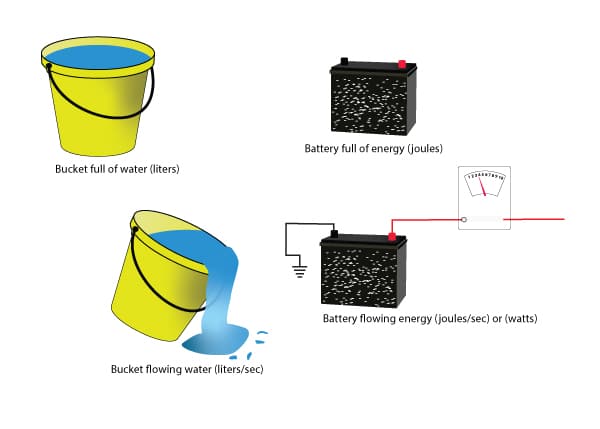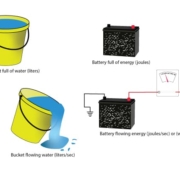Understanding Energy and Power
Energy: The concept of energy is likened to water for the easiest understanding. A bucket of water holds a specific amount of water which is measured in a quantity of gallons or liters. It is finite; when it is all drained out, it is gone. To gain more, it must be replaced from a source.
In the same manner, energy is measured in a quantity like gallons or liters are to water. Energy quantity is measured in joules. The battery itself is likened to the bucket. The battery holds a certain amount of joules of energy and when it is all gone, it is gone. To gain more usable electricity on your boat, you must add more joules back into your battery.

Power: The concept of power is likened to a quantity of water flowing out of the bucket over time. While draining the bucket of water, the water is flowing out at a certain rate. If a 10-liter bucket drains out in 1 minute, the flow rate out is 10 liters per minute or 600 liters per hour.
Power is the flow rate or usage of energy over time measured in joules of energy per second of time. One joule of energy used every second is one watt of power. Thus, electrical devices are rated in watts – the amount of energy per second the device uses while it is ‘on’. The longer you leave the device on, the greater amount of energy is consumed and drained from your limited resource energy-holding batteries.
To summarize the above: Energy is a quantity, and power is the rate of usage of that energy over time.
When you are on a sailboat on a sailing vacation or cruising, you are the energy manager. As such, you’re going to need to understand the mathematics of it all and constantly do energy audits. When sailing at home, this is rarely an issue because typically at the end of the day you go back home and plug into the shore power. When sailing abroad, plugging into shore power rarely happens every night.
To put this all in perspective, a fridge/freezer unit on a sailboat is typically rated at 60 watts. This means that every second it is on and cooling it uses 60 joules of energy. But like a fridge at home, the fridge is not always running. It cools down to the right temperature then the thermostat switches the fridge off. When heat enters in through the walls of the fridge and raises the temperature a few degrees, the fridge turns back on and starts consuming 60 watts of power or 60 joules of energy every second to cool the fridge back down to its thermostat setting.
Let’s say you load the fridge up with warm beer. After 1 hour of full running the fridge would have used:
60 watt-hours or 60 j/sec *3600 sec/hr * 1 hr = 216,000 joules.
But that number, 216,000 joules really doesn’t mean much. So engineers have made the concept simpler by using watt-hours which is also a measure of energy (1 watt-hr = 1 joule/sec * 3600 sec/hr = 3600 joules). Since power (the flow rate of energy) is measured in watts, it is more practically meaningful to list energy in watt-hrs instead of joules. i.e. if you use 1 joule per second for 3600 seconds you would have used 3600 joules. Since one joule per second is one watt and 3600 seconds is one hour this is 1 watt.hour (watt.hr).
Engineers use watt-hrs as the meaningful unit of energy
In this case, the 60-watt fridge/freezer ran for 1 hour and used 60 watt-hrs of energy from the house battery bank. If the fridge/freezer ran on full cooling for 24 hours then it would use:
60 watts x 24 hours = 1440 watt-hours of energy – or 1.44. kilowatt-hrs.
In reality, the fridge does not run 100% of the time (unless loaded with warm stuff). The % of time it runs is called the duty cycle. Assuming the duty cycle is 50% then a full day of running the fridge and keeping the beer (and food) cold consumes 720 watt-hrs or 0.72 kilowatt-hrs of energy.






